Or search by topic
Number and algebra
Geometry and measure
Probability and statistics
Working mathematically
Advanced mathematics
For younger learners
Cylinder Cutting



We start off with this tube (like one from inside a roll of kitchen paper):

The tube has a seam running through it (that forms a helix) .You'll have to carefully cut along that seam and then open it out and flatten it a little.
Now you will notice a parallelogram. It will very easily return to the original cylinder shape, BUT we can produce another cylinder by putting the two shorter edges together.
Then you have a cylinder that looks more like this:

You are now encouraged to consider taking an $A4$ sheet of paper and cutting it at an angle, in such a way that you can roll it up to produce a similar cylinder (like the kitchen roll one). You then repeat the same cutting as above and create the second cylinder by rolling it up differently.
Examine the lengths and volumes of these two cylinders and the areas of the paper pieces.
Try many different examples by cutting differently.
Is there a way of cutting the $A4$ sheet to produce a shape in which both cylinders have the same volume?
Explore further the shaped pieces you've produced.
You may also like
Sponge Sections
You have been given three shapes made out of sponge: a sphere, a cylinder and a cone. Your challenge is to find out how to cut them to make different shapes for printing.
Which Solid?
This task develops spatial reasoning skills. By framing and asking questions a member of the team has to find out what mathematical object they have chosen.

